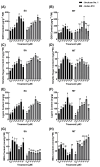Molecular Regulation of Antioxidant Defense and Metabolic Reprogramming in Xiaozhan Rice Genotypes: Differential Roles of Salicylic Acid and Melatonin Under Salt Stress
- PMID: 40699831
- PMCID: PMC12191652
- DOI: 10.3390/cimb47060432
Molecular Regulation of Antioxidant Defense and Metabolic Reprogramming in Xiaozhan Rice Genotypes: Differential Roles of Salicylic Acid and Melatonin Under Salt Stress
Abstract
Against the background of increasing global soil salinity, exogenous salicylic acid (SA) and melatonin (MT) have attracted much attention for their potential in regulating plant stress tolerance and have become an important research direction for the development of green and sustainable agriculture. In this study, the alleviating effects of different concentrations of SA (100-900 μM) and MT (100-900 μM) on salt stress (50 mM NaCl) and their physiological mechanisms were systematically investigated using the Tianjin specialty rice, Xiaozhan rice, as the research object. The results showed that salt stress significantly inhibited the germination and seedling growth of the two varieties, in which the salt-sensitive variety Jinchuan No. 1 showed significantly higher decreases in root length, plant height, and biomass (54.7-69.1%) than the salt-tolerant variety Jindao 919 (4.0-28.9%). Exogenous SA and MT were effective in mitigating salt stress injury, but there were genotypic differences in their pathways of action. For the first time in japonica rice, the genotype specificity of the SA/MT response was clearly revealed: SA dominated the response of salt-tolerant varieties by enhancing antioxidant defences, whereas MT optimized the overall performance of the salt-sensitive varieties through scavenging of reactive oxygen species, and in addition, it was further determined that SA and MT exhibited optimal mitigating effects on both varieties in the 300-700 μM concentration range, showing the best mitigation effect for both varieties. This finding provides an important theoretical basis and technological paradigm for precision stress tolerance cultivation of saline rice, and the application of appropriate concentrations of SA/MT according to genotype specificity to reduce the dependence on agrochemicals is of practical value in promoting green and sustainable production in saline agriculture.
Keywords: Xiaozhan rice; genotype interactions; melatonin; salicylic acid; salt stress.
Conflict of interest statement
The authors declare no conflicts of interest.
Figures




References
-
- Qadir M., Quillérou E., Nangia V., Murtaza G., Singh M., Thomas R.J., Drechsel P., Noble A.D. Economics of salt-induced land degradation and restoration. Nat. Resour. Forum. 2014;38:282–295. doi: 10.1111/1477-8947.12054. - DOI
-
- FAO . Global Status of Salt-Affected Soils—Main Report. FAO; Rome, Italy: 2024. - DOI
-
- Shao H., Chu L., Lu H., Qi W., Chen X., Liu J., Kuang S., Tang B., Won V. Towards sustainable agriculture for the salt-affected soil. Land Degrad. Dev. 2019;30:574–579. doi: 10.1002/ldr.3218. - DOI
-
- Mohanavelu A., Naganna S.R., Al-Ansari N. Irrigation Induced Salinity and Sodicity Hazards on Soil and Groundwater: An Overview of Its Causes, Impacts and Mitigation Strategies. Agriculture. 2021;11:983. doi: 10.3390/agriculture11100983. - DOI
Grants and funding
LinkOut - more resources
Full Text Sources

